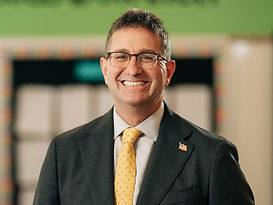GUEST COLUMN.
EDUCATING THE PUBLIC: A BRAVE NEW WORLD
By Daniel Bevarly Founder of the Democracy Kitchen and former executive director of the National Freedom of Information Coalition

Disseminating information about government and public affairs is a basic responsibility of the news media in a democratic society. The Founders believed it was important for a formal institution, independent of government, to have the responsibility to oversee, vet, and inform the public about government affairs and guarantee it with constitutional protection.
However, with rapid advancements in digital communication the landscape is changing. Social media supplements and at times circumvents the role of the traditional press as a means for state and local governments to get their messages across to a broad audience. This trend introduces new challenges and opportunities to inform, educate, and engage residents that impact government deliberations and policymaking.
Many public officials argue that using these enabling technologies improves efficiency in delivering information to larger, more diverse populations they serve. The journalism community warns that when the government circumvents the news media, residents become vulnerable to government influence with unvetted information that may lack accuracy or contain slanted content. There are elements of truth to both perspectives.
Compounding the complexity of the issue are the historically low levels of public trust in both the government and the news media. In the context of a functioning democracy, acknowledging this reality becomes crucial in understanding the dynamics between the message and the messenger, and the public's response.
For the most part, the goal of governments is to inform and educate the residents they serve, and it’s not a surprise that they are increasingly inclined to meet the public on common ground. “The percentage of American adults who use social media for news, sometimes or often, is now at 55%,” according to Amy Mitchell, the Pew Research Center’s director of journalism. That’s up from the presidential election of 2016, when 42% of adults received at least some news from social media.
Enabling technologies present opportunities to expand the dissemination of public information, but caution must be taken. Government managers can play a pivotal role in enhancing the quality of public information and education. Here are three recommendations that advocate for cultural shifts within public organizations –which are never easy:
1. Treat the news media as a VIP member of your constituency. Proactively utilize technology to work with the traditional news media in disseminating information to the public about your agency’s programs and policies.
Consider your department as one of many digital entry and dissemination points to the media and the public. Go from an information gatekeeper to an information gateway using technology to stream relevant content to a wider audience.
Work with your communication manager to build relationships with journalists through regular media briefings and position yourself as a point of contact for media inquiries that address your span of control within the administration.
2. Use a dedicated technology platform beyond social networks. A scalable, enterprise technology public engagement platform is essential to sharing information on a large scale. Each agency should have its designated portal providing easy access to information for the public and the media.
Public engagement platforms benefit your agency and the news media in two ways. First, it is a proactive repository for information about your programs and policies the public and the media can easily access. Second, it serves as a collection point for public input and feedback. The information and exchanges amplify your message to a larger audience and can identify topics of interest the news media may want to follow up on. Your communications director and IT department are key internal partners.
3. Build news media partnerships for informed public discourse. Governments use public forums to inform residents about public policies and projects. The media’s role has been that of an observer.
Partner with the news media to cosponsor public forums, both conventional and online, and share responsibility for managing public information and feedback. Each institution serves a different role and purpose as a public information provider. However, working together provides inclusive background and analyses which help build public support and trust and minimize misinformation.
Be creative with the partnership in navigating community awareness around other critical public issues, such as misinformation education and digital media literacy campaigns.
The digital age has ushered in new challenges and opportunities for the primary institutional providers of public affairs information –the press and the public sector. While technological changes empower governments to play an increased role in information dissemination, trust must be preserved – a goal which is becoming ever more difficult.
To restore public trust, both the government and the news media must build meaningful relationships with the residents they serve and with each other. Improving their roles as public information providers becomes the first and most crucial step in navigating the complexities of governing in the digital age while upholding the principles of democracy.
The contents of this guest column reflect the sentiments of the author and not necessarily those of Barrett and Greene, Inc.



































































































